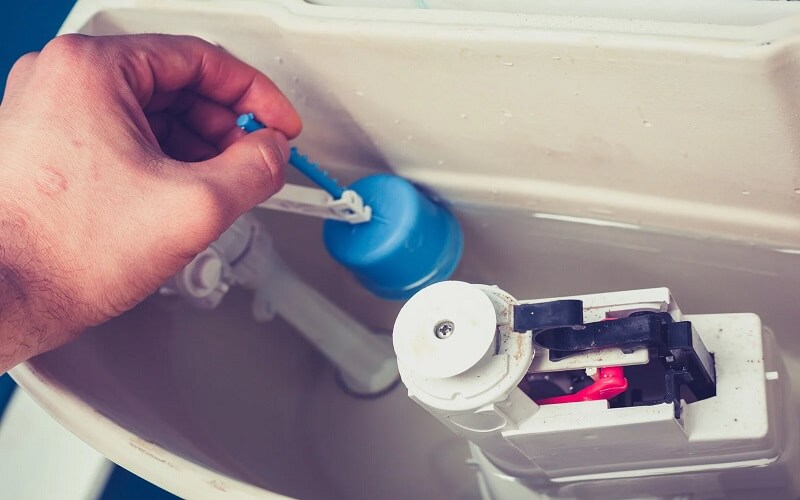The R&T Toilet Fill Valve is made to address leakage, smelly, and non-refilling toilets, enhance toilet functionality and conserve water. They are among the market’s universal fit tank fill valves.
The valve is designed to provide years of trouble-free flushing. Here are some quick and easy measures you can take to maintain and clean fill valve toilet, keeping it in peak functioning order.
Guide To Toilet Fill Valve Cleaning
If your tank takes a while to fill or if the toilet fill valve continues to drip even after the tank is full there may be debris in the fill valve that is keeping the valve from opening or shutting smoothly
To clean the fill valve and restore things to normal, just follow these easy steps:
1. Check the Fill Valve of your Toilet First
Search for any color changes in the fill valve, it may feel yellow and bleached. This suggests aging and wear that might impair the fill valve’s functionality.
2. Replace the Fill Valve with Any Toilet Fill Valve in this Situation
Additionally, check for leaks at the water supply line leading to the fill valve. To prevent floods and property damage, replace it if it is worn out or older than five years.

Photo Credit: Canva
How To Clean A Toilet Fill Valve
Toilet fill valve cleaning does not require complicated steps and can be done easily following the following steps
You’ll Need These Tools to Clean Your Toilet Tank:
- White vinegar (depending on your tank capacity)
- Gloves
- Cleaner
- Sponge
- Scrub Brush with Plastic Bristles
Step 1: Turn Off the Toilet’s Water Supply
The first step is to turn off the water supply. By using the water control valve to stop the water flow, you may easily drain the water tank. Find the valve, which is typically around the base of the toilet or on the wall behind the tank. To stop the flow of water, turn the valve clockwise.
Step 2: Drain the Tank
The tank’s lid should be removed and put out of the way. Until the tank is totally drained, flush the toilet. It can take two or three flushes to completely empty the tank, depending on tank’s capacity.
Step 3: Unscrew the Fill Valve Cap on the Toilet
This fill valve’s top gray cap can be removed. Simply grasp and hold the fill valve’s shaft with one hand while rotating the cap of the valve counterclockwise.
Step 4: Clean Fill Valve Toilet
If you live in an area where there is hard water there are chances that the fill valve’s exterior may have calcium and mineral buildup, in that case, you should clean the valve with vinegar and an old toothbrush to dissolve and remove the buildup. After cleaning the valve with warm, soapy water, rinse it with fresh water.
Additionally, you can also place an upside-down cup over the head of an uncapped valve, turn on the water completely for three to four seconds, and then turn it off. To clean the valve, repeat this two times.
Any sediment or debris that might have been impeding the fill valve’s functionality should be flushed out by this water burst. Once it has been cleaned, you can reinstall the fill valve’s top and tighten it with a clockwise twist.
Upkeep Your Toilet Tank
Consider using drop-in tablets to help preserve your toilet tank and prevent the accumulation of mold, corrosion, and bacteria, making it much easier to clean the next time around. This will help you avoid unpleasant buildup and time-consuming cleaning sessions.
Search for tablets that are non-toxic and chlorine free; some drop-ins’ strong chemicals have been known to corrode and harm toilet tank components.

Photo Credit: Canva
Clean Fill Valve Toilet – FAQs:
Can a Toilet Fill Valve Get Clogged?
Over time, debris in the opening of the valve can cause it to shut off suddenly as it progressively closes, ultimately clogging it.
How do you Clean a Dual Flush Valve?
To clean a dual flush valve release the pin holding the float cup arm and take off the blue cap from the fill valve’s top. With a forceful downward pressure, turn the cap to the left. Rinse with water after removing the rubber.
Will Vinegar Clean Toilet Jets?
Vinegar can be a wonderful cleaner for toilet rim jets since it fights mold, sanitizes surfaces of bacteria, and removes mineral buildup.
Can you put Vinegar in Toilet Tank?
A fantastic toilet cleaning remedy is vinegar. It’s naturally antibacterial, chemical-free, and acid, so it will remove small amounts of lime and calcium deposits without harming your toilet’s tank.
Can you put Bleach in Toilet Cistern?
Bleach is the biggest no when it comes to toilet tanks. Bleach and items containing bleach should never be used within the tank since they might corrode the toilet’s interior components.
What Causes a Toilet to Fill Slowly?
One of four potential causes—a clogged vent, a clogged drain, broken plumbing, or a blocked pipe could explain why your toilet takes a long time to fill.
How do you Increase Water Flow in Toilet?
On the valve’s top, there is an adjustment screw that can be turned in a clockwise direction to raise the water level and in a counterclockwise direction to lower it.
Conclusion:
Overall, following the instructions in this tutorial will help you clean a toilet fill valve. You might need to spend money on a new valve if the current one is still not functioning properly. Depending on the quality of the valve, how frequently the toilet is flushed, and whether the residence has hard water, toilet fill valves can last up to 5 years or even longer. A fill valve, however, might eventually clog or start to leak, just like any valve that is frequently exposed to water.
